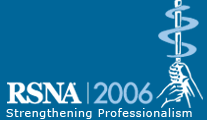
Abstract Archives of the RSNA, 2006
Sebastian Tobias Schindera MD, Presenter: Nothing to Disclose
Rendon Clive Nelson MD, Abstract Co-Author: Consultant, General Electric Healthcare, Inc
Research support, Bracco Diagnostics, Inc
Research support, E-Z-EM, Inc
Research support, Valleylab, Inc
Ellie Rose Lee MD, Abstract Co-Author: Nothing to Disclose
David Delong, Abstract Co-Author: Nothing to Disclose
Tracy Anne Jaffe MD, Abstract Co-Author: Nothing to Disclose
John Thomas MBBS, Abstract Co-Author: Nothing to Disclose
William Moreau Thompson MD, Abstract Co-Author: Nothing to Disclose
et al, Abstract Co-Author: Nothing to Disclose
Our preliminary anthropomorphic phantom study simulating an obese patient demonstrated a significant image noise reduction on multidetector computed tomography (MDCT) with an optimized protocol without substantially increasing the radiation dose to the deep organs. In this study we evaluated quantitatively and qualitatively the image quality and the overall diagnostic acceptance of abdominal MDCT scans in obese patients using the optimized protocol.
Fifty patients (33 women, mean age: 53 years) with a Body Mass Index >40 were prospectively enrolled for a clinically indicated abdominal MDCT scan (LightSpeed 16, GE Healthcare). All patients were scanned with an optimized Protocol A (detector configuration-16x1.25mm, pitch-1.375, table speed- 27.5mm/rotation, rotation time- 1.0sec, 140kVp, 380mA). Noise was subsequently added using dedicated software to the same dataset to simulate our standard Protocol B: 16x1.25mm, 1.375, 27.5mm/rotation, 0.5sec, 140kVp, 380mA, respectively. Quantitative analysis included measurements of the noise and the contrast-to-noise ratio (CNR) of the psoas muscle-to-fat. Three independent readers assessed image sharpness, noise, streak artifacts, and overall diagnostic acceptance using a 5-point scale (1= unacceptable/severe; 5= excellent/minimal). Statistical analysis consisted of the paired Student’s t-test.
The optimized Protocol A revealed a 40% mean decrease of image noise and a 76% mean increase of muscle-to-fat CNR compared to Protocol B. Differences in CNR and noise value were statistically different (p<0.001). Mean quality scores for Protocol A vs Protocol B were: image sharpness (4.3±0.7 vs 3.4±0.9), noise (4.3±0.6 vs 3.5±0.9), streak artifacts (4.5±0.6 vs 3.9±0.9), and overall diagnostic acceptance (4.0±0.8 vs 3.2±0.9). Statistical analysis revealed a significant difference for the four assessment points (p<0.001).
Our optimized abdominal MDCT protocol for obese patients yields significantly improved image quality and diagnostic acceptance.
By improving the image quality on abdominal MDCT scans in obese patients, the sensitivity and specificity of lesion detection may increase.
Schindera, S,
Nelson, R,
Lee, E,
Delong, D,
Jaffe, T,
Thomas, J,
Thompson, W,
et al, ,
Optimization of Abdominal Multidetector CT in Obese Patients: Assessment of Image Improvement and Diagnostic Acceptance. Radiological Society of North America 2006 Scientific Assembly and Annual Meeting, November 26 - December 1, 2006 ,Chicago IL.
http://archive.rsna.org/2006/4438930.html

